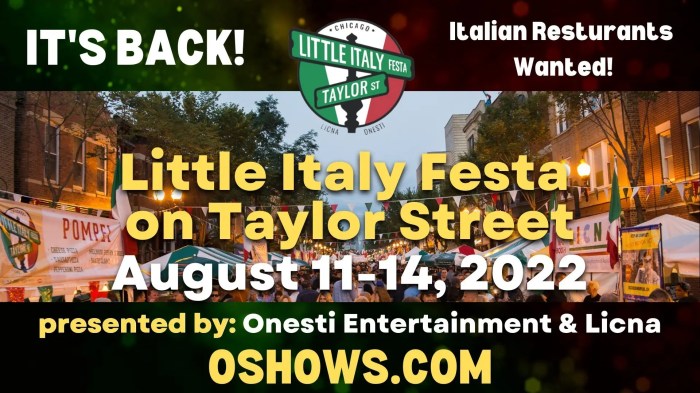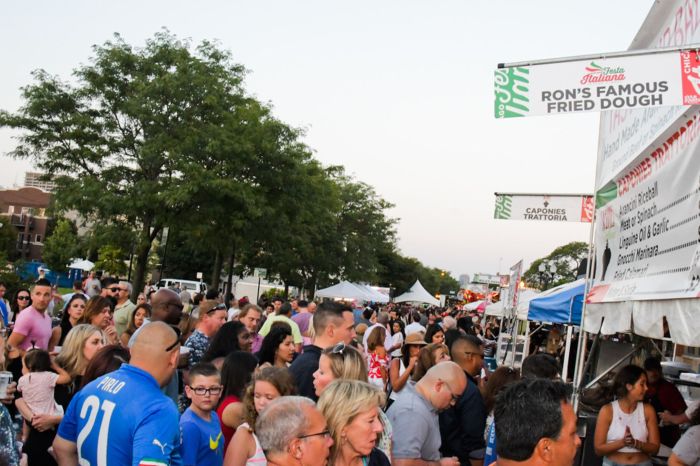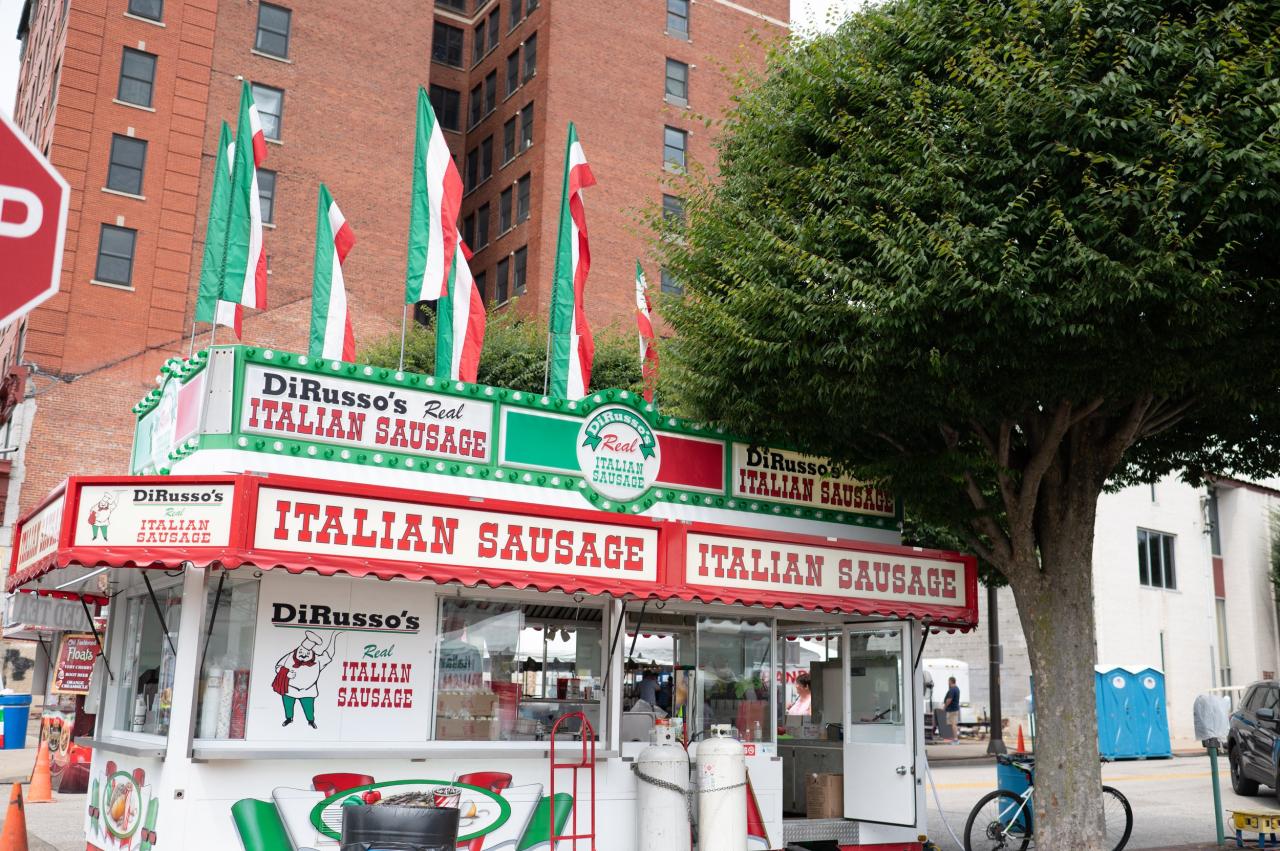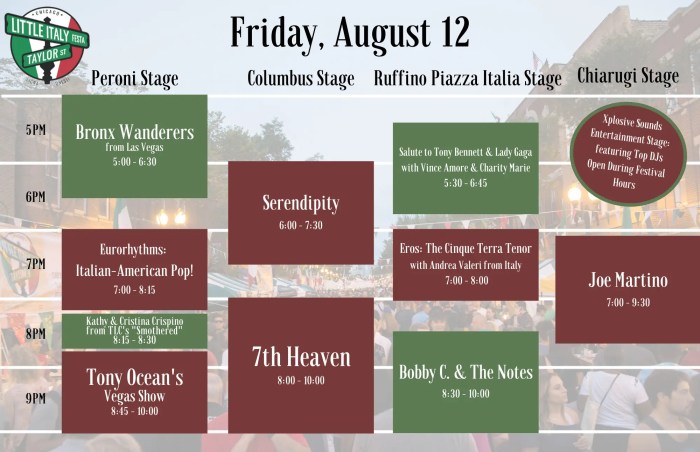Italian Festival Chicago: Dive into a vibrant tapestry of culture, cuisine, and community. From its humble beginnings, Chicago’s Italian festivals have blossomed into spectacular celebrations, showcasing the rich heritage and traditions passed down through generations. These aren’t just events; they’re immersive experiences that transport you to the heart of Italy, right in the Windy City. Prepare to be captivated by the sights, sounds, and tantalizing aromas that define this uniquely Chicagoan tradition.
This deep dive explores the history, evolution, and enduring impact of Chicago’s Italian festivals. We’ll uncover the stories behind some of the most popular events, sample the delectable food and drink, and experience the electrifying music and entertainment. Discover the cultural significance of these festivals, their economic contributions to the city, and the enduring spirit of Italian-American community in Chicago.
Get ready for a truly unforgettable journey.
Popular Chicago Italian Festivals

Chicago boasts a vibrant Italian-American community, resulting in a plethora of fantastic festivals celebrating the rich culture and traditions of Italy. These events offer a delicious blend of food, music, art, and family-friendly activities, attracting both locals and tourists alike. Understanding the key differences and similarities between these festivals allows you to maximize your enjoyment and experience the unique charm each one offers.
Chicago Italian Festivals: A Comprehensive Overview
The following table provides a snapshot of some of Chicago’s most prominent Italian festivals, highlighting their locations, dates, and key attractions. Remember that dates can vary year to year, so always check official websites for the most up-to-date information.
| Festival Name | Location | Dates (Approximate) | Key Features |
|---|---|---|---|
| Taylor Street Festa Italiana | Taylor Street (Little Italy) | Late Summer/Early Fall | Traditional Italian food, live music, street performers, carnival rides, and religious processions. |
| Feast of the Madonna di San Giovanni | Taylor Street (Little Italy) | June | Religious procession, Italian-American cultural displays, food vendors, and community gatherings. |
| Italian Festa in Bridgeport | Bridgeport neighborhood | Summer | Focus on Italian-American heritage, featuring local businesses, live entertainment, and family-friendly activities. |
| Saint Anthony’s Festa | Various locations (check for specific year) | Summer | Religious celebration centered around Saint Anthony, typically including religious services, food, and entertainment. |
| Rosemont’s Italian Festival | Rosemont | Summer | Large-scale festival with diverse Italian food offerings, live music, and family-oriented entertainment. |
Comparison of Three Major Chicago Italian Festivals
This table compares three of Chicago’s largest and most popular Italian festivals, highlighting their unique selling propositions. By understanding these differences, you can choose the festival that best aligns with your interests and preferences.
| Festival Name | Unique Aspects | Target Audience |
|---|---|---|
| Taylor Street Festa Italiana | Authentic Little Italy experience, strong emphasis on traditional Italian food and cultural displays, religious processions. | Those seeking a traditional, deeply rooted Italian-American cultural experience. |
| Rosemont’s Italian Festival | Larger scale, more diverse food options, broader range of entertainment, significant focus on family-friendly activities. | Families and those seeking a large-scale festival with a wide variety of entertainment options. |
| Feast of the Madonna di San Giovanni | Strong religious component, more intimate community feel, focused on the history and traditions of the Italian-American community in Little Italy. | Those interested in a religious celebration with a strong emphasis on Italian-American heritage and community. |
Most Anticipated Events and Activities at Chicago Italian Festivals
Chicago’s Italian festivals offer a wide array of engaging activities. Expect to find delicious Italian food, from classic pasta dishes to regional specialties. Live music performances, often featuring traditional Italian music, create a lively atmosphere. Many festivals incorporate carnival rides and games, perfect for families with children. Religious processions are a hallmark of some festivals, providing a glimpse into the deeply rooted faith of the community.
Street performers, artisan crafts, and cultural displays further enrich the experience. The overall atmosphere is one of vibrant community spirit, delicious food, and joyous celebration.
Cultural Aspects of Chicago Italian Festivals

Chicago’s Italian festivals are vibrant showcases of Italian heritage, offering a captivating blend of culinary delights, music, dance, and religious traditions. These events go beyond mere entertainment; they serve as powerful vehicles for cultural preservation and community building within the city’s substantial Italian-American population. The festivals’ success lies in their ability to authentically represent Italian culture while simultaneously adapting to the unique context of Chicago.These festivals offer a compelling glimpse into the richness of Italian culture.
Attendees can experience the lively energy of traditional Italian music, often featuring folk songs and popular melodies that resonate across generations. The visual spectacle of elaborate processions, often featuring religious iconography, provides a window into the deep-seated faith that forms a cornerstone of Italian identity. Furthermore, the festivals are a culinary journey, showcasing a wide array of regional Italian dishes, from classic pasta preparations to regional specialties, often prepared by families who have passed down their recipes through generations.
This tangible representation of Italian culinary artistry solidifies the festivals’ cultural significance.
Family and Community Involvement in Chicago Italian Festivals
Family and community participation are integral to the success of Chicago’s Italian festivals. These events are not simply organized; they arecreated* by the community, reflecting a deep-seated sense of collective ownership and pride. Multiple generations of families often collaborate, contributing their time, skills, and treasured recipes. Grandparents share their culinary expertise, parents manage logistics, and children participate in performances, creating a multi-generational experience that strengthens family bonds and reinforces cultural transmission.
This collective effort fosters a powerful sense of community, transforming the festivals into vibrant expressions of shared identity and heritage. The collaborative spirit is evident in everything from the preparation of food to the organization of parades and the performance of traditional dances.
The Role of Festivals in Preserving Italian Heritage in Chicago
Chicago’s Italian festivals play a crucial role in preserving and promoting Italian heritage within the city. In an increasingly globalized world, maintaining cultural identity can be challenging. These festivals provide a vital platform for preserving traditions that might otherwise fade with time. The passing down of recipes, songs, and stories through generations ensures that Italian-American culture remains vibrant and relevant.
The festivals also serve as an educational tool, exposing younger generations to their heritage and fostering a sense of pride in their cultural roots. This active engagement with the past helps to shape the identity of Italian-Americans in Chicago and strengthens their connection to their ancestral homeland. The festivals’ success in achieving this lies in their ability to balance tradition with adaptation to the contemporary Chicago context, creating a unique and enduring cultural legacy.
Economic Impact of Chicago Italian Festivals: Italian Festival Chicago

Chicago’s Italian festivals are more than just celebrations of heritage; they’re significant economic drivers for the city. These vibrant events inject substantial capital into the local economy, boosting tourism and supporting a wide range of businesses, from small family-run restaurants to larger hospitality venues. The ripple effect of this influx of spending is felt throughout various sectors, demonstrating the festivals’ substantial contribution to Chicago’s overall financial health.These festivals attract a large influx of tourists, both domestic and international, eager to experience authentic Italian culture and cuisine.
This surge in tourism translates directly into increased revenue for hotels, restaurants, transportation services, and other businesses catering to visitors. Moreover, the festivals provide a platform for local businesses to showcase their products and services to a massive audience, generating significant sales and brand awareness. The economic impact extends beyond the immediate festival period, with many visitors choosing to extend their stays, exploring other aspects of Chicago and contributing further to the city’s economy.
Tourism Revenue Generation
The influx of visitors during Italian festivals significantly boosts hotel occupancy rates, leading to substantial revenue for the hospitality sector. Restaurants experience a surge in demand, particularly those offering traditional Italian cuisine. Transportation services, including taxis, ride-sharing apps, and public transportation, also benefit from increased ridership. Consider, for example, the annual Festa Italiana, which typically attracts tens of thousands of attendees.
Based on conservative estimates of an average visitor spending $100 per day (including accommodation, food, and entertainment), a festival attracting 50,000 attendees over a three-day period could generate $15 million in direct spending. This figure doesn’t account for indirect economic benefits like increased employment or tax revenue.
Support for Local Businesses
Chicago’s Italian festivals provide a vital platform for local businesses, particularly those within the Italian-American community. Small, family-owned restaurants and food vendors often see a significant increase in sales during these events. Artisans and craftspeople can showcase and sell their products, gaining exposure and boosting their income. For instance, a small pasta maker might sell hundreds of pounds of pasta during a festival, generating far more revenue than they would in a typical week.
This increased economic activity helps sustain these businesses and contribute to the vibrancy of Chicago’s neighborhoods.
Hypothetical Economic Analysis
While precise statistical data on the combined economic impact of all Chicago Italian festivals is difficult to obtain, a hypothetical analysis can illustrate their potential contribution. Let’s assume there are five major Italian festivals annually, each attracting an average of 40,000 attendees over a three-day period. Using the conservative estimate of $100 per attendee per day, the total direct spending generated would be $60 million annually.
This figure, however, only represents a portion of the overall economic impact. Indirect economic benefits, such as increased employment and tax revenue, would significantly increase this total. Furthermore, the long-term benefits, including increased brand awareness for local businesses and enhanced tourism, are difficult to quantify but undeniably substantial.
Visual Representation of a Chicago Italian Festival

A Chicago Italian festival is a vibrant tapestry woven from sights, sounds, and smells, a sensory explosion that encapsulates the rich heritage of Italian-American culture in the city. It’s more than just an event; it’s an immersive experience that transports attendees to the heart of Italy, right in the middle of Chicago.The visual elements of these festivals are as diverse and delicious as the food itself.
Imagine strolling through the festival grounds, a bustling scene teeming with activity. String lights draped overhead create a warm, inviting glow, while vibrant banners and colorful flags representing Italy and Chicago flutter in the breeze. Tables overflow with an array of tempting treats, from rich, saucy pastas to crispy, golden-brown arancini, and fragrant loaves of bread.
Festival Grounds and Decorations, Italian Festival Chicago
The festival grounds are typically set up in a large, open space, often a park or plaza. Rows of brightly colored tents and booths house food vendors, artisan craftspeople, and games. These booths are often decorated with images of iconic Italian landmarks, such as the Leaning Tower of Pisa or the Trevi Fountain, further immersing visitors in the Italian atmosphere.
Large posters showcasing Italian-American history and culture add another layer of visual richness. Music spills from various points, creating a lively and upbeat ambiance. The air itself is thick with the aroma of roasting meats, simmering sauces, and freshly baked pastries, a symphony of scents that tantalizes the senses.
A Key Moment at a Chicago Italian Festival
Picture this: It’s a sunny afternoon at a Chicago Italian festival. A large family is gathered around a table laden with food. A grandmother, dressed in a vibrant floral dress and a brightly colored headscarf, beams with pride as she shares stories with her grandchildren. Her grandchildren, dressed in their Sunday best, eagerly devour plates piled high with spaghetti and meatballs.
The adults, dressed in a mix of casual and more formal attire, are engaged in lively conversations, punctuated by laughter and the clinking of glasses. The scene is filled with warmth, joy, and a palpable sense of community. The colors are bold and striking: the deep red of the sauce, the bright green of the basil, the golden yellow of the pasta, all contrasting beautifully against the rich browns and earth tones of the wooden tables and the colorful clothing.
The textures are equally varied: the smooth, silky pasta, the crunchy bread, the soft, yielding texture of the meatballs.
Vibrant Colors and Textures
The visual experience of a Chicago Italian festival is a kaleidoscope of colors and textures. Think of the rich, deep reds of marinara sauce, the vibrant greens of fresh basil and arugula, the sunny yellows of lemons and pasta. These are complemented by the earthy browns of breads and meats, and the creamy whites of cheeses. The textures are just as diverse: the smooth, velvety texture of gelato, the crispy crunch of pizza crust, the soft, pillowy texture of focaccia bread.
The visual feast is enhanced by the lively patterns and colors of the clothing worn by attendees, ranging from traditional Italian attire to modern, casual wear. The overall effect is a vibrant, exciting, and unforgettable sensory experience.
Chicago’s Italian festivals are more than just celebrations; they’re living testaments to the enduring power of cultural heritage and community spirit. They offer a vibrant window into the rich tapestry of Italian-American life in Chicago, providing an economic boost while simultaneously preserving and promoting a cherished culture. The sights, sounds, tastes, and sheer energy of these festivals leave an indelible mark, reminding us of the importance of celebrating our diverse communities and the bonds that unite us.
So, plan your visit – you won’t regret it.